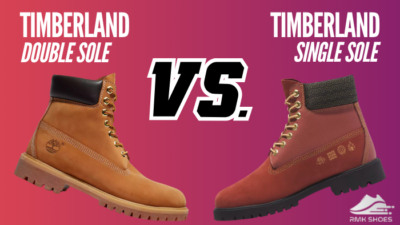The Ultraboost shoes from Adidas have curated the running crowd gracefully over the last few years. And with each iteration, these shoes saw welcoming upgrades to the already amazing lineup.
But the choice becomes unclear if you compare the latest Ultraboost Light against the previous version, the Ultraboost 22.
Which one of these deserves a spot in your shoe cabinet?
Let’s lace up both pairs and find out.
A Quick Rundown of Adidas Ultraboost 22 and Light
With the launch of the Ultraboost OG in 2015, Adidas has hit it home with this incredibly performant running shoe series.
It was also the first time they introduced the Boost midsole technology, which is also the reason behind the Ultraboost name. Those tiny beads of engineered foam quickly became the staple of this lineup, promising an unparalleled energy return and comfort.
Throughout all the releases, Adidas has maintained the motto of Ultraboost: a thick Boost midsole, Primeknit upper, and Continental rubber outsole.
Speaking of releases, the naming of Ultraboost shoes has been a bit inconsistent and confusing.
At first, it was Ultraboost 1, 2, 3, and 4. Later, they started naming these shoes by the last two digits of their release year, such as Ultraboost 19, 20, 21, and 22.
You’d imagine they’d release the later model as Ultraboost 23, right?
Nope! It’s now Ultraboost Light.
Thankfully, that’s the only annoyance about these running shoes. Everything else is top-notch, especially in the last two models.
Technical Comparison Between Adidas Ultraboost Light and Ultraboost 22
As the Ultraboost Light is an iterative update of the Ultraboost 22, there are a few notable differences in technical aspects. These dissimilarities can often become a major buying or avoiding reason since we all have different needs.
With that said, let’s see the technical differences between Adidas Ultraboost Light and Ultraboost 22:
| Features | Ultraboost Light | Ultraboost 22 |
|---|---|---|
| Weight | 10.3oz | 11.8oz |
| Sizing | True to size | True to size |
| Upper material | Recycled Primeknit Plus | Traditional Primeknit |
| Midsole | Lightboost foam | Boost foam |
| Stack height | 19.3-29.3mm | 21-31mm |
| Heel drop | 10mm | 10mm |
| Toe box | Narrower, tall profile | Wider, low profile |
| Outsole | Continental Rubber | Continental Rubber |
Such dissimilarities might not seem much at a glance, but trust me, these slight variances can end up giving a notably different user experience. This brings us to our main topic.
Differences Between Adidas Ultraboost Light and Ultraboost 22
Most yearly updates of a footwear lineup generally see an iterative change. It’s not a massive or apparent upgrade, but the underlying small changes really make a difference in the overall user experience.
The same can be said about the Ultraboost 22 and its newer iteration, the Ultraboost Light.
For example, both of these kicks offer a very similar design aesthetic and sizing. The only notable change is the difference in material, which in turn has a notable impact on the overall feel and performance of these shoes.
To know more, we’ve discussed the dissimilarities between Adidas Ultraboost Light and Ultraboost 22:
1. Weight Reduction
Having a lighter running shoe has its own set of benefits as long as it doesn’t sacrifice other important aspects to reduce weight.
As the name suggests, Adidas had a keen focus on providing lightweight yet responsive shoes when they came up with Ultraboost Light.
The Ultraboost Light(10.8oz) is around 1.5oz lighter compared to the Adidas Ultraboost 22(11.8oz) for men’s 9 US size. It might seem a bit trivial, but the lightweight feel of these shoes really contributes to the overall agility during a run or outdoor workout.
I really liked this light pair since they reduce fatigue after a long haul. So, the Ultraboost Light takes the crown in weight comparison.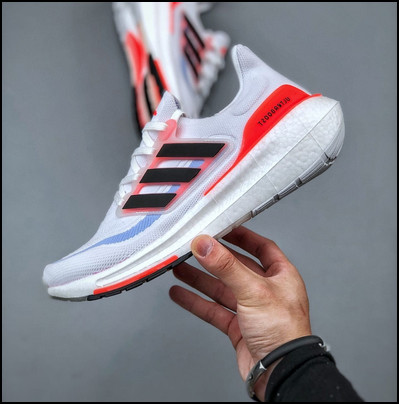
2. Construction & Materials
The construction materials contribute a lot to getting the lighter build of the Ultraboost Light compared to Ultraboost 22.
While achieving this feat, the newer model saw some trade-offs in certain areas while gaining some points in others.
Upper Material
The Ultraboost 22 uses traditional Primeknit in its upper, which is made from synthetic yarns and 50% recycled polyester.
It’s a slightly more supportive and durable but less breathable material.
Meanwhile, the Ultraboost Light has a newly engineered Primeknit Plus upper. This recycled material is not only eco-friendly but also has a thinner and lighter feel to it.
As a result, it has more breathability than Ultraboost 22, which is ideal for hot weather or sweaty feet.
The downside?
Ultraboost Light has a much less sturdier build compared to Ultraboost 22. It’s also more prone to wear and tear and might not hold up well in high-mileage runs or rough terrain.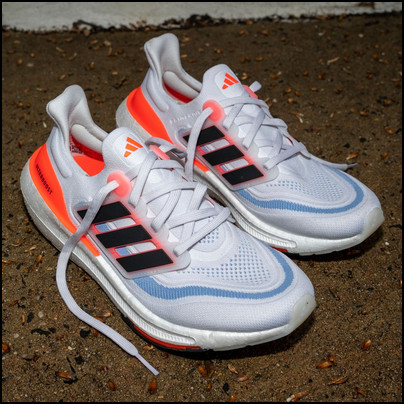
Another thing you should keep in mind is that the Light has a sleeker design but fewer colorways compared to the 22. So, the older model might serve well for the fashion freaks.
But they both have a very similar aesthetic and look with a pronounced swoosh. And they are both vegan-friendly as well.
Midsole
The biggest update that was applied in the newer Ultraboost model is the change, or dare I say, upgrade to the midsole foam.
Up until Ultraboost 22, Adidas has been using their tried and tested Boost foam technology to deliver unprecedented rides. The superior cushioning and energy return of these midsoles are the primary reasons why most runners prefer this lineup.
To take things up a notch, Adidas decided to improve this midsole and introduce a newly engineered foam called Light Boost in the Ultraboost Light footwear.
It might seem like Adidas has shaved off the midsole of the Ultraboost 22 and called it a Light Boost, as the newer model has a lower stack height.
But that’s actually not the case here.
This Light Boost foam is an airier version of the previous iteration, which still retains the springy and responsive characteristics.
However, the Ultraboost Light didn’t have the same stability and spongy cushioning as it did on Ultraboost 22.
It didn’t quite suit my running style, as I prefer maximum cushioning and a high-energy return.
Outsole
Both Ultraboost Light and 22 boast Continental rubber outsoles for decent traction and wear resistance.
But to shed some weight, Adidas has opted for less crystal rubber in Light compared to 22. The lugs are also a bit shallower on the newer model.
As a result, the Ultraboost 22 has a better grip on various surfaces, but by a very small margin.
In search of a lightweight build, the Adidas Ultraboost Light has gone through some reductions. Such characteristics have made the Ultraboost 22 a slightly better option in terms of having more user-friendly materials.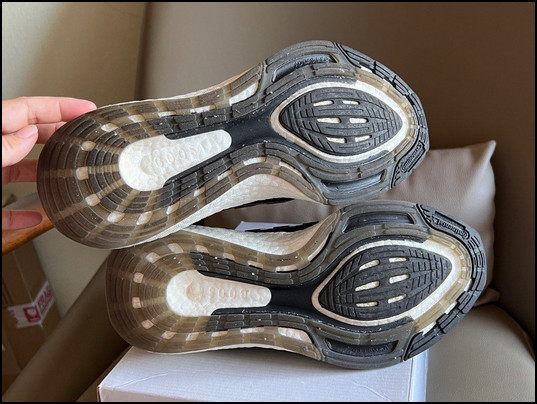
3. Fit and Sizing
Both Ultraboost Light and 22 are usually considered true-to-size. But the overall build of these shoes has slight differences, which can affect the fit of these shoes based on your physique.
Let me explain how.
Toe Cap
Ultraboost 22 has a slightly wider toe box, albeit at a lower profile. As a result, it feels easier and more comfortable for a wide forefoot like mine.
On the flip side, the Ultraboost Light has a slightly narrower forefoot area with a taller profile.
You can easily wiggle your toes in these kicks, but I’d recommend going half a size large if you’re concerned about bunions or blistering.
Tongue and Lacing
The padded tongue and traditional lacing system of 22 provide comfort and a secure lockdown feel during technical runs.
Nonetheless, the thinner and streamlined tongue of Ultraboost Light offers more foot room and lighter weight at the compromise of comfort. The flat, integrated lacing of this shoe might have less adjustability compared to 22, but it doesn’t fail to provide a snug fit.
Both shoes have reinforced eye stays with similar numbers of eyelets. So you don’t have to worry about loose laces while running.
Ultimately, both dupes offer a similar fit and sizing experience, with Ultraboost 22 gaining a slight upper hand due to a wider toe cap.
4. Performance and Comfort
Denser and supportive elements in a shoe offer much better control in slower-paced long runs. But they come at a cost of less agility and fatigue.
The Ultraboost Light primarily targets such scenarios with its responsive midsole and adaptive/breathable upper.
Yes, the Light has less cushioning and comfort compared to 22, but it hasn’t negatively impacted my running or workout experience that much.
As a matter of fact, the breathable and lightweight build of the newer model has kept my feet happier throughout the days. The overall comfort is a bit less than the competitor’s, but not to a degree where you’d regret buying it.
The only scenario where the Light fell short of 22 is in the traction, as the latter has more grip in the heel area.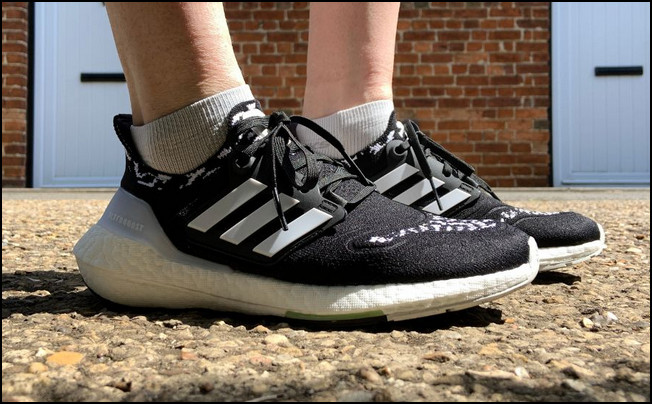
In general, the Ultraboost 22 offers a bit more support and stability, while the Ultraboost Light provides better agility and energy return for faster runs or tempos.
5. Durability in the Long Haul
As I have previously mentioned, the outsole of Ultraboost 22 has deeper lugs with more crystal rubber in the high-wear areas, such as the heel.
Adidas decided to remove this extra rubberized area in their later model to reduce the weight even further.
I’m not sure how much weight they managed to reduce, but it definitely wasn’t worth it. This change not only made the Light more prone to wear, but it also became less grippy in tricky situations.
Just after 3 months of use, I began to notice the outsole wearing on the newer model.
In contrast, I have been using the Ultraboost 22 for over half a year now and still haven’t noticed any crease in the upper or outsole wear.
Hence, the Adidas Ultraboost 22 gets a clear win when it comes to durability.
Pros and Cons of Adidas Ultraboost 22 and Light
Each of these Adidas shoes has its own strengths and weaknesses.
If we just discuss the key differences instead of looking at the advantages/disadvantages of each model, we won’t be able to make a sound purchase decision.
That’s where the pros and cons of Adidas Ultraboost Light and Ultraboost 22 come in:
Adidas Ultraboost Light
- »Agile and lightweight feel.
- »More breathable Primeknit plus upper material.
- »Improved heel lockdown, thanks to the modified heel counter.
- »Less cushioning and support.
- »Less durable.
- »Fewer color options.
Adidas Ultraboost 22
- »Plush cushioning is suitable for long runs.
- »More support and durability.
- »Enhanced traction and wear resistance.
- »More colorways.
- »Slightly heavier.
- »Less breathable material.
If you’re still on the edge and can’t figure out which shoe has hit the winning formula for you, move on to the verdict for a conclusive answer.
Adidas Ultraboost Light vs 22: Which Is The Better Dupe?
The Adidas Ultraboost 22 is still one of the best running shoes in the market, even beating the latest Ultraboost Light in certain aspects like comfort and durability. Hence, it is my personal pick for high-mileage running, as it can tackle both paved roads and rough terrain.
That being said, the Ultraboost Light is also a great option for those who prefer lighter footwear. Such shoes have a separate fanbase, but I felt like Adidas didn’t fully execute its uncompromised feel.
I’d recommend trying out both shoes to get a feel for which one will serve you best.
But if I have to pick an overall winner suitable for the masses, I’d pick the Ultraboost 22 in a heartbeat.
Frequently Asked Questions
Which Ultraboost models from Adidas are the best?
Currently, the Ultraboost Light, 22, and ATR from Adidas are the best picks for running shoes. From lightweight and supportive to well-cushioned and responsive, each of these models excels in their own perspective.
What is the difference between Adidas Ultraboost and Lightboost?
Light Boost is the foam technology that’s been used in the Adidas Ultraboost Light shoes. It is actually the midsole of these shoes, not a separate shoe lineup.
Are Ultraboost 23 and Ultraboost Light the same shoes?
Yes. Adidas has chosen to designate the new Ultraboost shoe as Ultraboost Light, a departure from its standard naming conventions.


